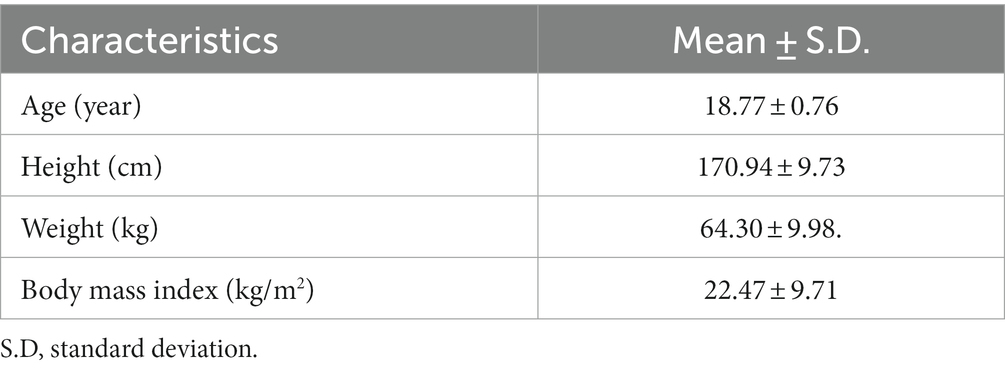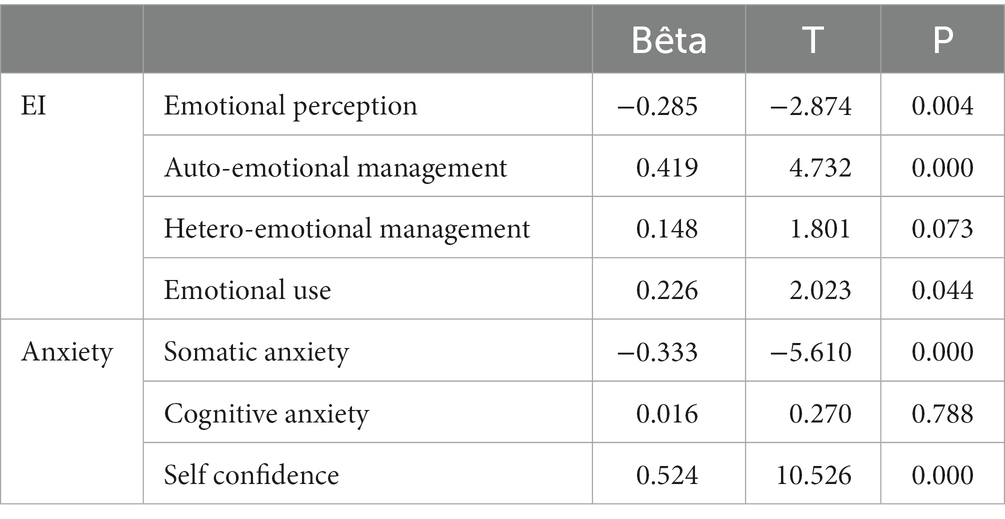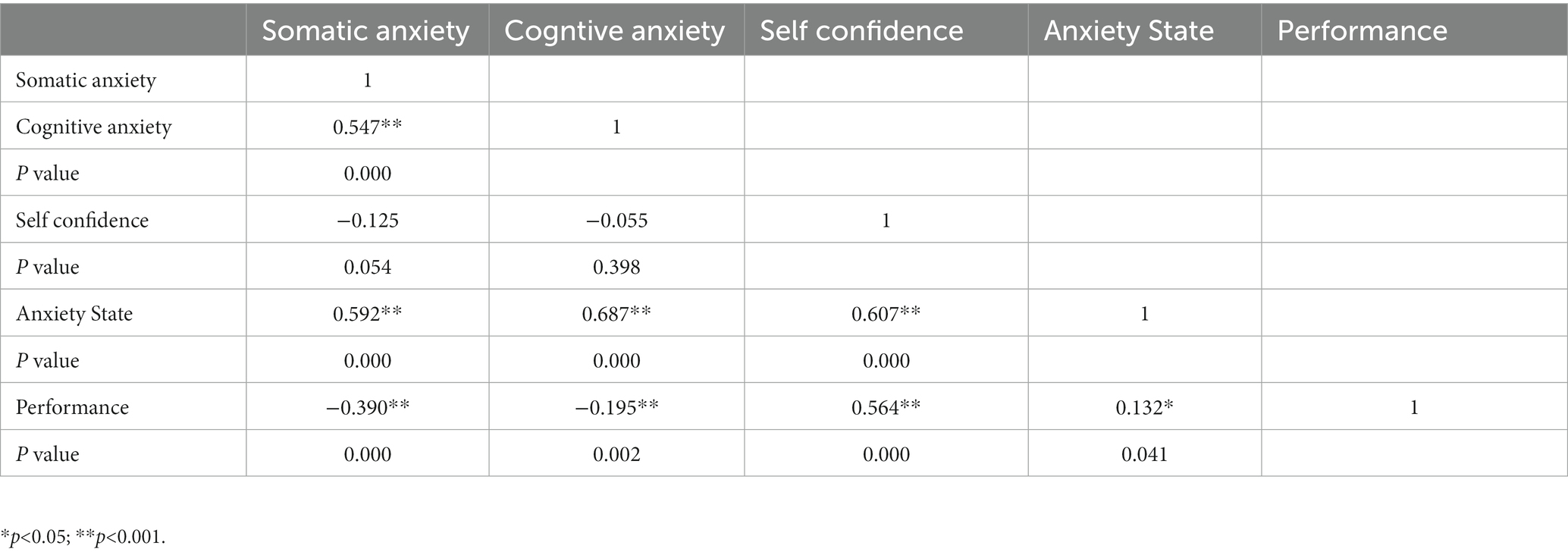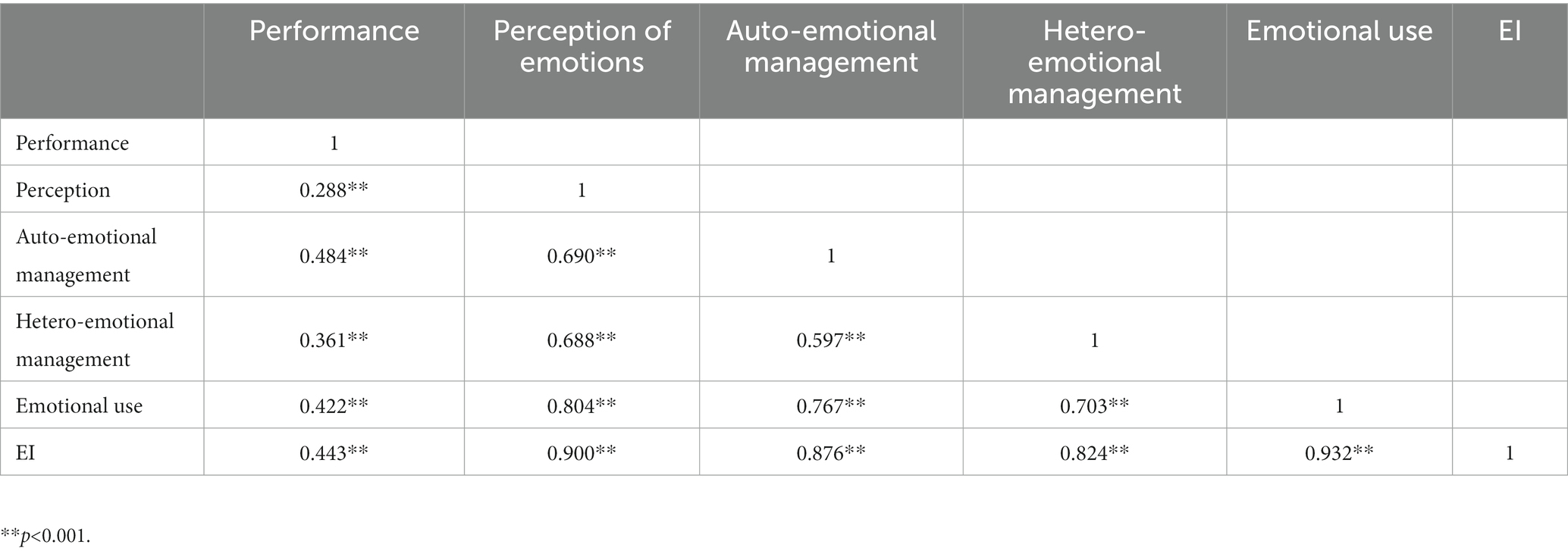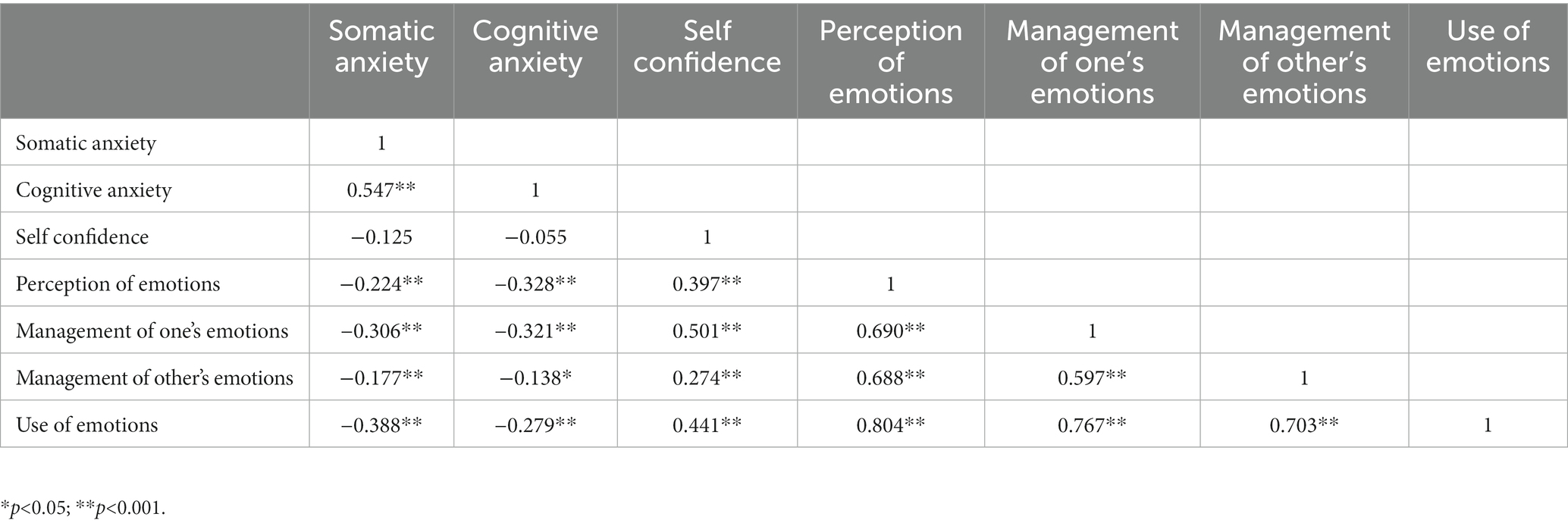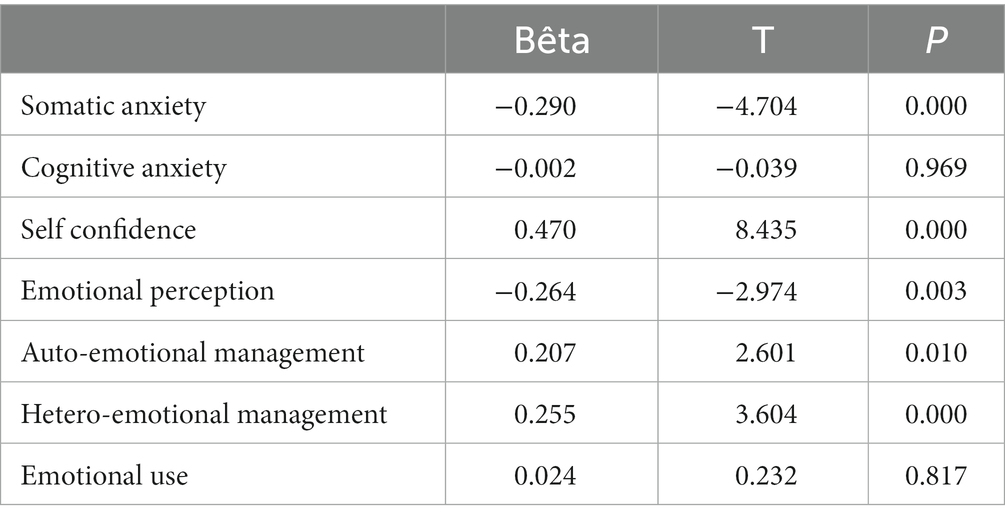- 1Higher Institute of Sport and Physical Education, Sfax, Tunisia
- 2Higher Institute of Sport and Physical Education Ksar-Said, Tunis, Tunisia
- 3Physical Activity, Sport and Health, Research Unit (UR18JS01), National Observatory of Sport, Tunis, Tunisia
- 4Faculty of Medicine of Tunis, Tunis, Tunisia
- 5Higher Institute of Humanities, Zaghouan, Tunisia
- 6Department of Arts and Social Sciences, Sfax University, Sfax, Tunisia
Emotional intelligence (EI) has been recently the main target in research on sports psychology. The objectives of this study were to investigate the relation between self-report measures of emotional intelligence, pre-competitive anxiety, and performance among students during the physical education exam of the high school final year. This cross-sectional study was conducted on a sample of 350 students attending the physical education exam in the year 2021–2022. Analysis of the correlations between the scores of Emotional intelligence and anxiety showed that self-confidence was positively correlated with all dimensions of Emotional intelligence (Beta = 0.524; p = 0.000). Multivariate linear regression analysis showed that the most related items to performance were self-confidence in a positive direction (r = 0.56; p = 0.000) and negatively with somatic anxiety (r = −0, 39; p = 0.000). Considering the Emotional intelligence subscales, hetero-emotional management was significantly positively associated with performance (p = 0.000) however emotional perception was negatively correlated with performance (p = 0.003). These results demonstrate the importance of social and emotional learning programs for improving self-confidence and better management of emotions during physical education and sports.
1. Introduction
Emotions have always been the main target of research in psychology (Izard, 2009). Knowledge of the causes and the consequences of emotions as well as the management of emotional situations constitute important elements to achieving high-performance (Tyng et al., 2017). Many contemporary conceptual orientations have taken a positive psychology perspective regarding the identification of performance-facilitating influences such as emotional intelligence (Sánchez-Álvarez et al., 2020). The concept of emotional intelligence (EI) has been defined since 1997 by Salovey and Sluyter as the ability of the person to identify and understand his emotions and those of others and to regulate them to achieve optimal performance (Salovey and Sluyter, 1997). Anxiety is also one of the most studied emotional aspects in psychology. According to the literature, performance can be negatively affected by stressing factors mainly during competitions and exams (Sanhueza et al., 2016). Anxiety has been defined as negative feelings and tension resulting from environmental demands associated with arousal (Rowland and van Lankveld, 2019). These demands are usually stressful, indicating a perceived imbalance between the given demand and their ability to meet the demand (Ford et al., 2017).
Interest in EI has spawned work in multiple fields, including sports and physical education, which is particularly fertile ground to explore due to the preponderance of emotions with an objective of high-performance (Laborde et al., 2013; Kopp and Jekauc, 2018). EI plays an important role in physiological responses to stress and anxiety, and their results on performance (Lea et al., 2019). In sports, managing emotions and anxiety is considered one of the keys to performance (Tur-Porcar and Ribeiro-Soriano, 2020). So, according to the literature, there is a relationship between emotions, EI, and sports performance (Meyer and Fletcher, 2007; Lane et al., 2012; Üngür and Karagözoğlu, 2013). Thus, the meaning of this relationship remains controversial. The meta-analysis of Laborde et al. (2016) on EI summarized the results of six studies examining the relationship between EI and athletic performance and concluded with conflicting results and suggested the need for further studies. In the Arabic world and Tunisia data on this subject are scarce. In this order, this study was conducted to study the relation between self-reported measures of emotional intelligence, anxiety, and performance among students during the physical education exam of the final year of high school, constituting a real stressful situation with an objective of high performance. Thus, we hypothesized that being the EI and its dimensions negatively correlated with anxiety, dimensions of anxiety are negatively correlated to high student performance, while EI is positively correlated. The aim of this study was to investigate the impact of EI and anxiety on students’ performance during the final high school physical education exam, with the aim of revealing this, presumably negative, relationship between EI and physical performance.
2. Methods
2.1. Participants
This cross-sectional study was conducted on a sample of 350 students attending the physical education exam of the final year high school governorate of Zaghouan (Center west of Tunisia).
We used an online program1 to estimate the minimal sample size needed in this study. Multi-level sampling was used to determine the needed sample for this study. Schools and classes were determined by drawing lots.
In detail, we have chosen: 4 schools in the Governorate of Zaghouan using simple random sampling, 5 classes within each school using systematic sampling method, and 20 students from each school using simple random method. We used a Random Number Generator program to create a list of random numbers, based on our specifications. The students were selected according to an identifier accorded to each, obtaining the list of a representative sample of students.
Students in the high-year physical education exam were included in the study; they were healthy and free of any disabilities, musculoskeletal, neurological, or respiratory diseases or dysfunctions, and without any history of mental disorders or psychiatric drugs. Exclusion criteria were incomplete questionnaires. The anthropometric characteristics of students (mean ± SD) are shown in Table 1.
After approval of the concerned comities, the study investigators (four physical education professors) were present during the final high school physical education exam from the 18 to the 27 April, of the 2021/2022 school year, 8 a.m. to 11:30 a.m. to fill the questionnaires just before the exam. The investigators asked for the approval of each student to participate in the study (from the selected sample of students) and explained how to complete the questionnaires; then, asked them to complete the two questionnaires (SSRI and CSAI-2r). Each questionnaire took from 10 to 15 min to be completed.
The study was conducted according to the latest version of the Declaration of Helsinki, and the protocol was fully approved by the Local Ethics Committee of the National Center of Medicine and Science of Sports of Tunis (CNMSS-LR09SEP01) before the commencement of the procedure.
To estimate the minimal sample size needed in this study, we used the following formula:
where n = sample size; N = population size; Z = the statistic corresponding to level of confidence; p = probability of success; q = probability of failure; e = confidence interval. With a confidence level of 95%, a confidence interval of 5%, and the probability of success at 50%, the sample size required (depending on the Universe) was around 385.
2.2. Study measures
Two questionnaires were used to study the emotional intelligence and anxiety state among the studied population.
a. The Schutte self-report emotional intelligence test: the Schutte Self-Report Inventory (SSRI) was used to assess the as previously described by Zoghlami et al. (2022) and Schutte et al. (1998). EI was measured using the Schutte Self-Report Inventory also called Schutte Self-Report Emotional Intelligence Test. This scale measures the participants’ perception of their emotional skills at an intrapersonal and interpersonal level. It consists of 33 Likert items answered on a five-point scale (1 = strongly disagree, 2 = disagree, 3 = neutral, 4 = agree, and 5 = strongly agree). The EI scale describes four factors as follows: perception of emotions, managing self-emotions, managing others’ emotions, and utilizing emotions (emotional use). We used a validated (but still unpublished) Arabic version of the scale which showed good psychometric properties.
b. The revised inventory-2 of the anxiety state of the competition (Martinent et al., 2010): This version of the questionnaire contains 17 items and evaluates three main dimensions: cognitive anxiety, somatic anxiety, and self-confidence (Cox et al., 2003). Cognitive anxiety involves cognitions about possible failure, while somatic anxiety involves the perception of bodily symptoms and heightened negative arousal. Self-confidence, on the other hand, involves cognition that one is up to the task and able to give one’s best possible performance. We used a validated Arabic-Tunisian version (Hajji and Elloumi, 2017).
c. The Performance in this study was based on the result of the final physical education high school exam (over 20). The final high school exam results were considered as ‘Good ‘or ‘poor to medium’. This method facilitated the regression analysis, which needed a binary qualitative variable.
2.3. Procedure
Several investigators (physical education professors) were present (after approval of the concerned comities) during the final high school exam of physical education in the governorate of Zaghouan. Each student was given to complete the two questionnaires (SSRI and CSAI-2r) just before passing the exam. Investigators obtained the approval of the participant and explained how to complete the questionnaires.
2.4. Data analysis
Data were analyzed with Statistical Package for Social Sciences (SPSS) software, version 17. Descriptive data are presented as percentages or as means and Standard Deviations (SDs). We tested the normality of all the continuous variables using the test of Kolmogrov-Smirnov [a variable is normally distributed if the Kolmogrov test is not significant (p > 0.05)]. Simple linear regression was used to explore relations between scores of emotional intelligence scales, anxiety subscales (SA, CA, and SC), and performance. Then multiple regression was performed to study the relation between anxiety, EI adjusted subscales, and performance. The limit of significance was fixed at 0.05.
2.5. Ethical considerations
We have obtained approval from the Youth and Sports Commission of the governorate of Zaghouan. Investigators obtained the participant’s approval before the interview and explained the study’s procedure and purpose.
3. Results
The present study was about 350 high school students during the final year physical education exam. The mean age of the studied population was 18.7 year ±0.76 and the gender ratio was 0.96 (49% males). The mean performance score among the studied population was 14.6 ± 3.9. The average EI score was 113 ± 20.8, the median was 112 with extremes ranging from 60 to 150. The 25th and the 75th quartiles were 96 and 133. Considering the different dimensions, the use of emotions had the highest average score of 3.7 ± 0.9. The mean scores for managing own and others’ emotions were 3.6 ± 0.8 and 3.4 ± 0.7. Perception of emotions had the lowest score of 3.2 ± 0.6 (Figure 1).
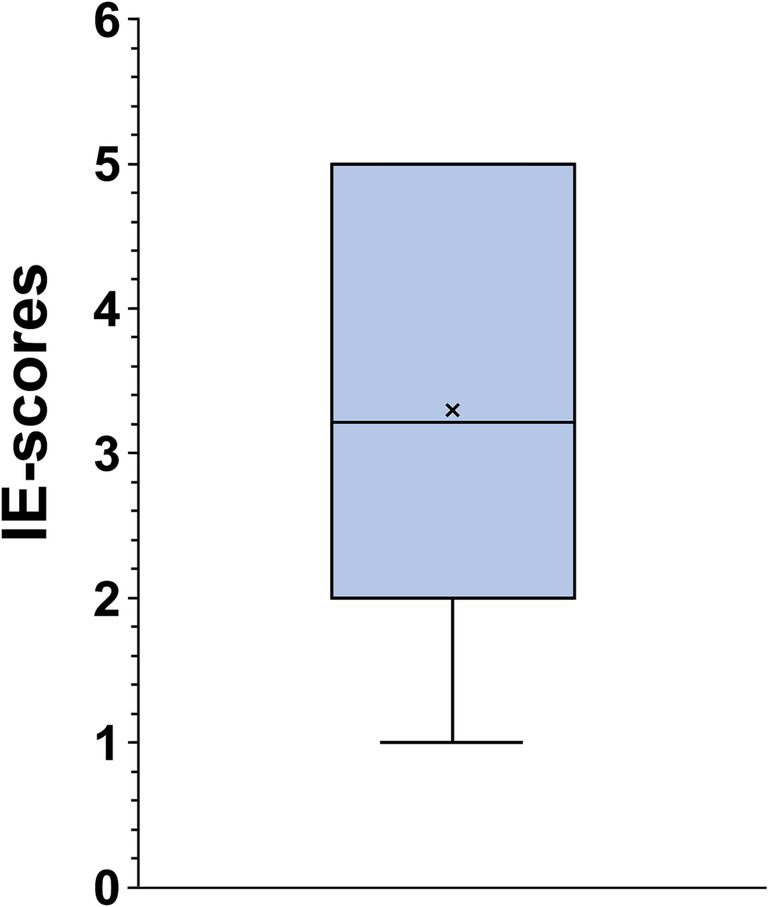
Figure 1. Scores of the items for emotional intelligence (EI). In this representation, the central box covers the middle 50% of the data values, between the upper and lower quartiles. The bars extend out to the extremes, while the central line is at the median.
Regarding anxiety, the highest average score in terms of intensity and frequency was that of somatic anxiety, followed by the score of cognitive anxiety, and finally, self-confidence (Figure 2).
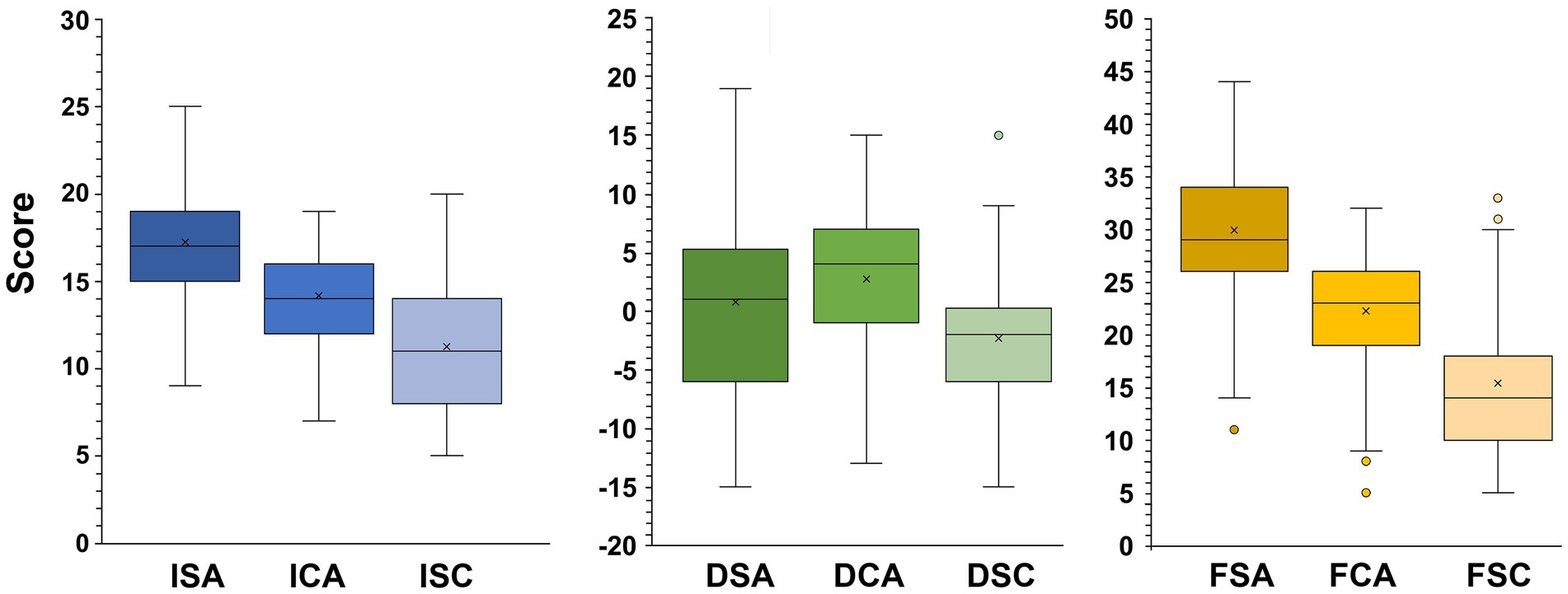
Figure 2. Score distribution for each subscale of the competition competitive state anxiety inventory. In this representation, the central box covers the middle 50% of the data values, between the upper and lower quartiles. Those values that are beyond 1.5 times the interquartile range beyond the central box are plotted as individual points. The bars extend out to the extremes, while the central line is at the median. ISA, Intensity Somatic Anxiety; ICA, Intensity Cognitive Anxiety; ISC, Intensity Self-Confidence; DSA, Direction Somatic Anxiety; DCA, Direction Cognitive Anxiety; DSC, Direction Self-Confidence; FSA, Frequency Somatic Anxiety; FCA, Frequency Cognitive Anxiety; FSC, Frequency Self-Confidence.
The mean of results corresponding to students’ performance was equal to the median of 15 ± 3.7, with extremes varying from 4 to 20.
3.1. Association between emotional intelligence, anxiety, and performance
We first tested the normality of all continuous variables, and the Kolmogorov test was not significant (p > 0.05). When considering the different dimensions, the most important association was observed between auto-emotional management and performance (Beta = 0.419; p = 0.000; Table 2). The average anxiety score among the studied population was 2.15 ± 0.44. Regarding anxiety subscales: Self-confidence was the most significantly associated item with the performance in a positive direction (Beta = +0.524; p = 0.000). There was also a significant association between somatic anxiety and performance in a negative direction (Beta = −0.333; p = 0.000; Table 2).
3.2. Correlations between anxiety items and performance
Correlation coefficients between dimensions of anxiety and performance were very significant in a positive direction for self-confidence (r = 0.56; p = 0.000) and in a negative direction for somatic anxiety (r = −0.39; p = 0.000; Table 3).
3.3. Correlations between emotional intelligence items and performance
Correlation coefficients between dimensions of EI and performance were very significant in a positive direction with coefficients of 0.48 for auto-emotional management, 0.42 for emotional use, and 0.36 for Hetero-emotional management. The total EI score was correlated positively with performance with r = 0.44 (Table 4).
3.4. Correlation between emotional intelligence scales and anxiety
Analysis of the correlation between the dimensions of EI and anxiety showed that self-confidence was positively correlated with all dimensions of EI: the most important correlation was the management of one’s emotions (r = 0.501; p = 0.01) followed using emotions (r = 0.441; p = 0.01). somatic anxiety was negatively correlated with all dimensions of EI: essentially the use of emotions (r = −0.38; p = 0.01) and the management of emotions (r = −0.306; p = 0.01). Cognitive anxiety was also negatively correlated with the dimensions of EI; the highest correlations were the perception of emotions (r = −0.328; p = 0.01) and the management of one’s emotions (r = −0.321; p = 0.01; Table 5).
3.5. Multivariate analysis between anxiety, emotional intelligence, and performance
After multivariate linear regression analysis, self-confidence was related to performance in a positive direction and somatic anxiety in a negative one. Considering EI subscales, Hetero-emotional management had a significant association with performance in a positive direction however, emotional perception was related to performance in a negative direction. In a less important but significant relation, auto-emotional management was also related to performance (Table 6).
4. Discussion
In this study we hypothesized and demonstrated the existence of a relationship between emotional intelligence, competitive anxiety, and student performance, focusing on it during the final high school physical education exam. According to the results of the present study, self-confidence was significantly related to performance in a positive direction. One of the most consistent findings in the peak performance literature is the significant correlation between self-confidence and successful sporting performance (Smith and Bar-Eli, 2007). Confidence has been consistently associated with positive affect, whereas a lack of confidence has been associated with anxiety, depression, and dissatisfaction (Martens et al., 1990). According to Vealey and Campbell (1988), subsequent levels of sports confidence influence an athlete’s thoughts, feelings, and behaviors, which determine sporting performance. Self-confidence would be directly related to performance whereas there is a complex relationship between anxiety and performance. Anxiety consists of two subcomponents: cognitive and somatic anxiety, which influence performance (Parnabas et al., 2013). According to our findings, somatic anxiety was associated with performance in a negative direction which is consistent with the literature (Mercader-Rubio et al., 2023). However, there was no significant association between cognitive anxiety and performance in this study, as in the previous study (Filippi et al., 2022). The level of competitive anxiety among athletes differs according to individuals (Hanin, 2003). Many types of research showed that winning in a competition depends on how athletes can control their anxiety levels. The athlete needs an optimal level of anxiety to perform well (Wagstaff, 2014; Martinent et al., 2015; Kopp and Jekauc, 2018). According to the literature, athletes’ ability to regulate individuals’ emotions involved in sporting performance is necessary to control and influence social activity to succeed at the highest level of competition in peak performance in competitive sports (Lane et al., 2009; Arribas-Galarraga et al., 2020; Tamminen et al., 2021). A meta-analysis investigation by Kopp and Jekauc (2018) concluded that a person high in El is good at recognizing and regulating emotions of self and others, can enhance positive emotion, and channel away negative emotions in self and others (Zoghlami et al., 2022). This was consistent with the findings of the present study which showed a significant positive association between auto and hetero-emotional management regarding performance whereas emotional perception was significantly associated with performance in a negative direction. Thus, the challenge behind perceptions as reality is not only to be aware of them but also to be able to transform negative perceptions into more positive ones. In fact, at the individual level, higher EI was found to be positively related to the use of psychological skills, such as imagery and self-talk (Lane et al., 2009) which have been proven to aid performance. Another positive effect of EI in sports is its effect on stress when under pressure (Arribas-Galarraga et al., 2020).
According to Kopp and Jekauc (2018), practitioners, such as applied sports psychologists, coaching staff, athletes, and sports administrators, need appropriate knowledge of the role of EI and its relevance for successful performance in major competitions. They also should promote the implementation of EI screening and EI development programs as an integral part of the training process.
In summary, although it is known that anxiety and EI are differently correlated with academic performance, this is the first study to show relationships with physical performance, in a group of students, during the final physical exam of high school.
These relationships have also been studied in young professional athletes (Castro-Sánchez et al., 2019), however, all our results are novel because they show in detail the effects of the dimensions of anxiety and EI on physical performance in students.
In particular, somatic anxiety is negatively correlated to high students’ performance; but such physical performance was not significantly associated with cognitive anxiety.
In our participants, EI was negatively correlated with somatic and cognitive anxiety. In addition, this study has shown how much high emotional Intelligence (especially management of emotions), self-confidence, and the management of anxiety are important to raise the performance among students in physical education and sports learning.
Nevertheless, this study contains some limitations such as the sample size which could have been larger, also other more detailed questionnaires to explore emotional intelligence could have been used but the conditions of the final high school physical education exam did not allow for an increase in the number of sizes of the population and the use of longer questionnaires. This study was about students, so the results are specific to this population. Further studies to explore the relationship between EI, anxiety, and performance among athletes of different specialties are recommended.
5. Conclusion
The findings of the present study showed that the most related item to performance among students during the final physical exam of high school was self-confidence in a positive direction. Emotional perception was independently and negatively associated with performance however hetero-emotional management was significantly associated with performance in a positive direction. These results lead to the importance of social and emotional learning programs to improve self-confidence and better management of emotions in Physical education and sports learning. Further studies are recommended to explore the interaction between EI and sports performance.
Data availability statement
The raw data supporting the conclusions of this article will be made available by the authors, without undue reservation.
Ethics statement
The studies involving humans were approved by Local Ethics Committee of the National Center of Medicine and Science of Sports of Tunis (CNMSS-LR09SEP01). The studies were conducted in accordance with the local legislation and institutional requirements. The participants provided their written informed consent to participate in this study.
Author contributions
WZ, AH, AE, and AM contributed to conception and design of the study. WZ and AH organized the database. WZ and KH performed the statistical analysis. WZ wrote the first draft of the manuscript. WZ, SMn, AM, and SMa wrote sections of the manuscript. All authors contributed to the article and approved the submitted version.
Acknowledgments
We would like to express our sincere gratitude to all the individuals and organizations that have contributed to the publication of this research paper.
Conflict of interest
The authors declare that the research was conducted in the absence of any commercial or financial relationships that could be construed as a potential conflict of interest.
Publisher’s note
All claims expressed in this article are solely those of the authors and do not necessarily represent those of their affiliated organizations, or those of the publisher, the editors and the reviewers. Any product that may be evaluated in this article, or claim that may be made by its manufacturer, is not guaranteed or endorsed by the publisher.
Footnotes
References
Arribas-Galarraga, S., Cecchini, J. A., Luis-De-Cos, I., Saies, E., and Luis-De Cos, G. (2020). Influence of emotional intelligence on sport performance in elite canoeist. J. Human Sport Exerc. 15, 772–782. doi: 10.14198/jhse.2020.154.05
Castro-Sánchez, M., Zurita-Ortega, F., Ubago-Jiménez, J. L., González-Valero, G., and Chacón-Cuberos, R. (2019). Relationships between anxiety, emotional intelligence, and motivational climate among adolescent football players. Sports (Basel) 7:34. doi: 10.3390/sports7020034
Cox, R. H., Martens, M. P., and Russell, W. D. (2003). Measuring anxiety in athletics: the revised competitive state anxiety inventory 2. J. Sport Exerc. Psychol. 25, 519–533. doi: 10.1123/jsep.25.4.519
Filippi, C. A., Subar, A., Ravi, S., Haas, S., Troller-Renfree, S. V., Fox, N. A., et al. (2022). Developmental changes in the association between cognitive control and anxiety. Child Psychiatry Hum. Dev. 53, 599–609. doi: 10.1007/s10578-021-01150-5
Ford, J. L., Ildefonso, K., Jones, M. L., and Arvinen-Barrow, M. (2017). Sport-related anxiety: current insights. Open Access J. Sports Med. 8, 205–212. doi: 10.2147/OAJSM.S125845
Hajji, J., and Elloumi, A. (2017). Validation of the Tunisian version of the French version of the competitive state anxiety inventory-2 revised (CSAI-2R), including frequency and direction scales. Int. J. Emerg. Ment. Health 19, 1–7. doi: 10.4172/1522-4821.1000363
Hanin, Y. L. (2003). Performance related emotional states in sport: a qualitative analysis. Forum qualitative Sozialforschung forum: qualitative. Soc. Res. 4, 1–31. doi: 10.17169/fqs-4.1.747
Izard, C. E. (2009). Emotion theory and research: highlights, unanswered questions, and emerging issues. Annu. Rev. Psychol. 60, 1–25. doi: 10.1146/annurev.psych.60.110707.163539.2
Kopp, A., and Jekauc, D. (2018). The influence of emotional intelligence on performance in competitive sports: a Meta-analytical investigation. Sports (Basel). 6:175. doi: 10.3390/sports6040175
Laborde, S., Dosseville, F., and Allen, M. S. (2016). Emotional intelligence in sport and exercise: a systematic review. Scand. J. Med. Sci. Sports 26, 862–874. doi: 10.1111/sms.12510
Laborde, S., Raab, M., and Dosseville, F. (2013). “Emotions and performance: valuable insights from the sports domain” in Handbook of psychology of emotions (Vol. 1): Recent theoretical perspectives and novel empirical findings. eds. C. Mohiyeddini, M. Eysenck, and S. Bauer (United States: Nova Science Publishers), 25–357.
Lane, A. M., Beedie, C. J., Jones, M. V., Uphill, M., and Devonport, T. J. (2012). The BASES expert statement on emotion regulation in sport. J. Sports Sci. 30, 1189–1195. doi: 10.1080/02640414.2012.693621
Lane, A. M., Thelwell, R. C., Lowther, J., and Devonport, T. J. (2009). Emotional intelligence and psychological skills use among athletes. Soc. Behav. Personal. Int. J. 37, 195–201. doi: 10.2224/sbp.2009.37.2.195
Lea, R. G., Davis, S. K., Mahoney, B., and Qualter, P. (2019). Does emotional intelligence buffer the effects of acute stress? Syst. Rev. Front Psychol. 10:810. doi: 10.3389/fpsyg.2019.00810
Martens, R., Burton, D., Vealey, R. S., Bump, L. A., and Smith, D. E. (1990). “Development and validation of the competitive state anxiety Inventory-2 (CSAI-2)” in Competitive anxiety in sport. eds. R. Martens, R. S. Vealey, and D. Burton (Champaign: Human Kinetics), 117–190.
Martinent, G., Ferrand, C., Guillet, E., and Gautheur, S. (2010). Validation of the French version of the Competitive State Anxiety Inventory-2 Revised (CSAI-2R) including frequency and direction scales, Psychol. Sport Exerc. 11, 51–57. doi: 10.1016/j.psychsport.2009.05.001
Martinent, G., Ledos, S., Ferrand, C., Campo, M., and Nicolas, M. (2015). Athletes’ regulation of emotions experienced during competition: a naturalistic video-assisted study. Sport Exerc. Perform. Psychol. 4, 188–205. doi: 10.1037/spy0000037
Mercader-Rubio, I., Ángel, N. G., Silva, S., and Brito-Costa, S. (2023). Levels of somatic anxiety, cognitive anxiety, and self-efficacy in university athletes from a Spanish public university and their relationship with basic psychological needs. Int. J. Environ. Res. Public Health 20:2415. doi: 10.3390/ijerph20032415
Meyer, B. B., and Fletcher, T. B. (2007). Emotional intelligence: a theoretical overview and implications for research and professional practice in sport psychology. J. Appl. Sport Psychol. 19, 1–15. doi: 10.1080/10413200601102904
Parnabas, V. A., Mahamood, Y., and Parnabas, J. (2013). The relationship between cognitive and somatic anxiety on performance of student-athletes of Universiti Malaysia Perlis (UNIMAP). Int. J. Human Movement Sports Sci. 1, 61–66. doi: 10.13189/saj.2013.010301
Rowland, D. L., and van Lankveld, J. J. D. M. (2019). Anxiety and performance in sex, sport, and stage: identifying common ground. Front. Psychol. 10:1615. doi: 10.3389/fpsyg.2019.01615
Salovey, P. E., and Sluyter, D. J. (1997) Emotional development and emotional intelligence: Educational implications. United States: Basic Books.
Sánchez-Álvarez, N., Berrios Martos, M. P., and Extremera, N. A. (2020). Meta-analysis of the relationship between emotional intelligence and academic performance in secondary education: a multi-stream comparison. Front. Psychol. 11:1517. doi: 10.3389/fpsyg.2020.01517
Sanhueza, J. A., Zambrano, T., Bahamondes-Avila, C., and Salazar, L. A. (2016). Association of Anxiety-Related Polymorphisms with sports performance in Chilean long distance triathletes: a pilot study. J. Sports Sci. Med. 15, 554–561.
Schutte, N. S., Malouff, J. M., Hall, L. E., Haggerty, D. J., Cooper, J. T., Golden, C. J., et al. (1998). Development and validation of a measure of emotional intelligence. Personal. Individ. Differ. 25, 167–177. doi: 10.1016/S0191-8869(98)00001-4
Smith, D., and Bar-Eli, M. Essential readings in sport and exercise psychology. United States: DIANE Publishing Inc. (2007).
Tamminen, K. A., Kim, J., Danyluck, C., McEwen, C. E., CRD, W., and Wolf, S. A. (2021). The effect of self-and interpersonal emotion regulation on athletes’ anxiety and goal achievement in competition. Psychol. Sport Exerc. 57:102034. doi: 10.1016/j.psychsport.2021.102034
Tur-Porcar, A., and Ribeiro-Soriano, D. (2020). The role of emotions and motivations in sport organizations. Front. Psychol. 11:842. doi: 10.3389/fpsyg.2020.00842
Tyng, C. M., Amin, H. U., Saad, M. N. M., and Malik, A. S. (2017). The influences of emotion on learning and memory. Front. Psychol. 8:1454. doi: 10.3389/fpsyg.2017.01454
Üngür, G., and Karagözoğlu, C. (2013). The relationship between emotional intelligence, social physique anxiety and life satisfaction in physical education and sports students. Int. J. Humanit. Soc. Sci. 3, 115–119.
Vealey, R. S., and Campbell, J. L. (1988). Achievement goals of adolescent figure skaters: impact on self-confidence, anxiety, and performance. J. Adolesc. Res. 3, 227–243. doi: 10.1177/074355488832009
Wagstaff, C. R. (2014). Emotion regulation and sport performance. J. Sport Exerc. Psychol. 36, 401–412. doi: 10.1123/jsep.2013-0257
Keywords: emotional intelligence, anxiety, sport, performance, physical education
Citation: Zoghlami W, Hawani A, Khiari H, Mnedla S, Marsigliante S, Elloumi A and Muscella A (2023) The relationship between emotional intelligence, anxiety, and performance in physical education and sport students. Front. Psychol. 14:1236070. doi: 10.3389/fpsyg.2023.1236070
Edited by:
Yongcong Shao, Beijing Sport University, ChinaReviewed by:
Manuel Gómez-López, University of Murcia, SpainGiuseppe Battaglia, University of Palermo, Italy
Copyright © 2023 Zoghlami, Hawani, Khiari, Mnedla, Marsigliante, Elloumi and Muscella. This is an open-access article distributed under the terms of the Creative Commons Attribution License (CC BY). The use, distribution or reproduction in other forums is permitted, provided the original author(s) and the copyright owner(s) are credited and that the original publication in this journal is cited, in accordance with accepted academic practice. No use, distribution or reproduction is permitted which does not comply with these terms.
*Correspondence: Antonella Muscella, YW50b25lbGxhLm11c2NlbGxhQHVuaXNhbGVudG8uaXQ=
 Wael Zoghlami
Wael Zoghlami Aymen Hawani
Aymen Hawani Hyem Khiari
Hyem Khiari Sofiene Mnedla
Sofiene Mnedla Santo Marsigliante
Santo Marsigliante Ali Elloumi
Ali Elloumi Antonella Muscella
Antonella Muscella